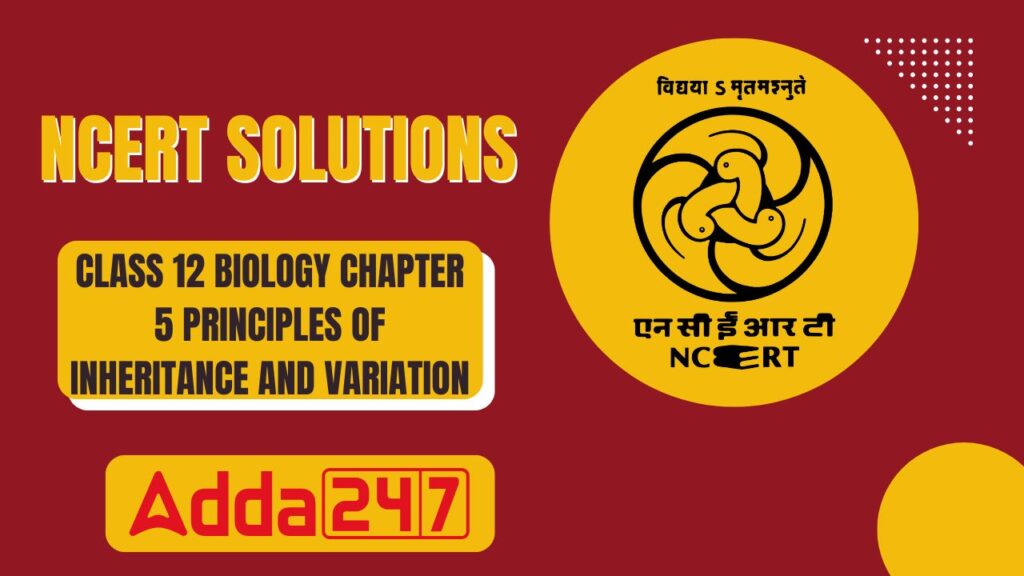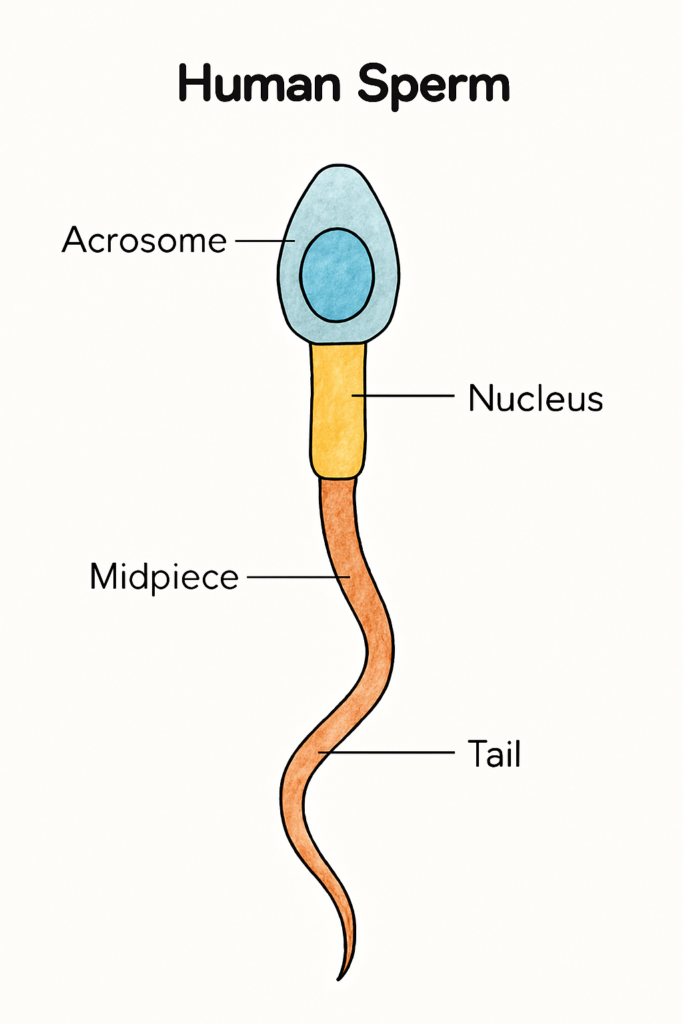
As per the CBSE Class 12 Biology syllabus, the Chapter 5 is Principles of Inheritance and Variation. This chapter shares great insights and knowledge about topics like Heredity, Inheritance, Mendel’s Laws, Chromosomal Theory of Inheritance, Chromosomal Theory of Inheritance, Gene Interaction and Polygenic Inheritance, etc.
It is essential that all students must study hard and ensure that they don’t have any doubts or confusion related to any topic in the chapter when going for the exam. Therefore, to help students improve their exam performance, we have added the NCERT Solutions for Class 12 Biology Chapter 5 Principles of Inheritance and Variation, in the article below.
Overview of Class 12 Biology Chapter 5
The Chapter 5 in the CBSE Class 12 Biology Syllabus revolves around the various studies and theories regarding Inheritance and Variation. Below, we have shared an overview of what students are to study in this chapter:
- Mendel’s Laws of Inheritance: Law of Dominance, Segregation, and Independent Assortment.
- Deviations from Mendel’s Laws: Incomplete dominance, codominance, polygenic traits, and multiple allelism.
- Chromosomal Theory of Inheritance: Linkage, recombination, and chromosome mapping.
- Sex Determination: Mechanisms in humans, birds, and insects.
- Mutations: Types and their role in variation.
- Genetic Disorders: Mendelian disorders (e.g., haemophilia, sickle-cell anaemia) and chromosomal disorders (e.g., Down syndrome, Turner syndrome).
- Significance: Understanding inheritance and variation is crucial for genetics, evolution, and medical applications.
NCERT Solutions for Class 12 Biology Chapter 5 Principles of Inheritance and Variation
To help students complete their preparations for the final examination of the Biology subject in class 12th we have added the NCERT Solutions for Class 12 Biology Chapter 5 Principles of Inheritance and Variation below:
Question 1: Mention the advantages of selecting pea plant for experiment by Mendel.
Answer: Gregor Mendel chose the pea plant (Pisum sativum) for his experiments due to the following advantages:
- Distinct Contrasting Traits: Pea plants exhibit clear, contrasting traits (e.g., tall vs. dwarf, yellow vs. green seeds), making it easy to observe inheritance patterns.
- Self-Pollination: Naturally self-pollinating, ensuring pure-breeding lines for controlled experiments.
- Cross-Pollination Feasibility: Flowers can be easily cross-pollinated by removing anthers (emasculation) and transferring pollen, allowing controlled hybridization.
- Short Life Cycle: Pea plants have a short generation time, enabling Mendel to study multiple generations quickly.
- Large Number of Offspring: Produces many seeds per cross, providing sufficient data for statistical analysis.
- Easy Cultivation: Pea plants are easy to grow and maintain under controlled conditions.
Question 2: Differentiate between the following:
(a) Dominance and Recessive
(b) Homozygous and Heterozygous
(c) Monohybrid and Dihybrid
Answer:
| (a) Dominance and Recessive: | ||
| Feature | Dominance | Recessive |
| Definition | An allele that expresses its phenotype in the heterozygous condition. |
An allele whose phenotype is masked in the heterozygous condition.
|
| Expression | Expressed in both homozygous (AA) and heterozygous (Aa) states. |
Expressed only in homozygous state (aa).
|
| Example | Tallness (T) in pea plants. |
Dwarfness (t) in pea plants.
|
| (b) Homozygous and Heterozygous: | ||
| Feature | Homozygous | Heterozygous |
| Definition | An individual with two identical alleles for a gene (e.g., TT or tt). |
An individual with two different alleles for a gene (e.g., Tt).
|
| Genotype | Pure-breeding (e.g., TT for tall, tt for dwarf). |
Hybrid (e.g., Tt for tall).
|
| Phenotype | Shows dominant or recessive trait. |
Shows dominant trait only.
|
| (c) Monohybrid and Dihybrid: | ||
| Feature | Monohybrid | Dihybrid |
| Definition | A cross involving one pair of contrasting traits. |
A cross involving two pairs of contrasting traits.
|
| Example | Cross for plant height (TT × tt). |
Cross for seed color and shape (YYRR × yyrr).
|
| Ratio (F2) | Phenotypic ratio: 3:1; Genotypic ratio: 1:2:1. |
Phenotypic ratio: 9:3:3:1; Genotypic ratio: 1:2:2:4:1:2:1:2:1.
|
Question 3: Explain the Law of Dominance using a monohybrid cross.
Answer:
- Law of Dominance: In a heterozygous condition, one allele (dominant) expresses its phenotype, masking the effect of the other allele (recessive).
- Monohybrid Cross Example:
- Cross: Pure tall pea plant (TT) × Pure dwarf pea plant (tt).
- F1 Generation: All offspring are heterozygous (Tt) and phenotypically tall, as the dominant allele (T) masks the recessive allele (t).
- F2 Generation: Self-pollination of F1 (Tt × Tt) produces a phenotypic ratio of 3 tall (TT, Tt, Tt) : 1 dwarf (tt) and a genotypic ratio of 1:2:1 (TT:Tt:tt).
- Explanation: The dominant allele (T) expresses tallness in both homozygous (TT) and heterozygous (Tt) conditions, while the recessive allele (t) is expressed only in the homozygous condition (tt).
Question 4: Define and design a test-cross.
Answer:
- Definition: A test-cross is a genetic cross between an individual with a dominant phenotype (genotype unknown, e.g., TT or Tt) and a homozygous recessive individual (e.g., tt) to determine the genotype of the dominant individual.
- Purpose: To identify whether the dominant individual is homozygous (TT) or heterozygous (Tt).
- Design:
- Example: Cross a tall pea plant (TT or Tt) with a dwarf pea plant (tt).
- Outcomes:
- If the tall plant is homozygous (TT): All offspring are tall (Tt), as all gametes from TT are T.
- If the tall plant is heterozygous (Tt): Offspring show a 1:1 phenotypic ratio (tall Tt : dwarf tt), as Tt produces T and t gametes equally.
- Diagrammatic Representation:
- Homozygous: TT × tt → All Tt (tall).
- Heterozygous: Tt × tt → 50% Tt (tall), 50% tt (dwarf).
Question 5: Using a Punnett square, work out the distribution of phenotypic features in the first filial generation after a cross between a homozygous female and a heterozygous male for a single locus.
Answer:
- Cross: Homozygous female (e.g., TT for tall) × Heterozygous male (e.g., Tt for tall).
Punnett Square:
| T (female) | T (female) | |
| T (male) | TT | TT |
| t (male) | Tt | Tt |
- F1 Generation:
- Genotypes: 50% TT (homozygous tall), 50% Tt (heterozygous tall).
- Phenotypes: 100% tall (since T is dominant).
- Explanation: All offspring are tall because the female contributes only T alleles, and the male contributes T or t, both resulting in tall phenotypes (TT or Tt).
Question 6: When a cross is made between tall plant with yellow seeds (TtYy) and tall plant with green seeds (TtYy), what proportions of phenotype in the offspring could be expected to be:
(a) tall and yellow
(b) dwarf and green
Answer:
- Cross: TtYy (tall, yellow seeds) × TtYy (tall, green seeds).
- Traits:
- Height: T (tall, dominant), t (dwarf, recessive).
- Seed color: Y (yellow, dominant), y (green, recessive).
- Punnett Square for Dihybrid Cross (simplified for phenotypes):
- Height (T_ = tall, tt = dwarf): Monohybrid ratio = 3 tall (TT, Tt, Tt) : 1 dwarf (tt).
- Seed color (Y_ = yellow, yy = green): Monohybrid ratio = 3 yellow (YY, Yy, Yy) : 1 green (yy).
- Combined Phenotypic Ratio (Law of Independent Assortment): 9:3:3:1.
- 9: Tall, yellow (T_Y_).
- 3: Tall, green (T_yy).
- 3: Dwarf, yellow (ttY_).
- 1: Dwarf, green (ttyy).
- Proportions:
- Tall and yellow: 9/16 (T_Y_).
- Dwarf and green: 1/16 (ttyy).
Question 7: Two heterozygous parents are crossed. If the two loci are linked, what would be the distribution of phenotypic features in F1 generation for a dihybrid cross?
Answer:
- Linked Genes: Genes on the same chromosome tend to be inherited together, reducing recombination compared to independent assortment.
- Cross: Heterozygous parents (e.g., TtYy × TtYy, where T and Y are linked).
- Expected Outcome:
- If genes are completely linked (no recombination), the F1 generation will resemble the parental phenotypes:
- Parental Combinations: Tall, yellow (TY) and dwarf, green (ty).
- Phenotypic Ratio: Approximately 3:1 (3 tall, yellow : 1 dwarf, green), as gametes are mostly TY or ty (no recombination).
- If partial linkage occurs (some recombination due to crossing over), recombinant phenotypes (tall, green; dwarf, yellow) appear in smaller proportions, deviating slightly from the 3:1 ratio.
- If genes are completely linked (no recombination), the F1 generation will resemble the parental phenotypes:
- Explanation: Unlike independent assortment (9:3:3:1 ratio), linkage restricts gene shuffling, favoring parental combinations in F1.
Question 8: Briefly mention the contribution of T.H. Morgan in genetics.
Answer: T.H. Morgan’s contributions to genetics include:
- Chromosomal Theory of Inheritance: Established that genes are located on chromosomes, using Drosophila melanogaster (fruit fly) as a model organism.
- Linkage and Recombination: Discovered that genes on the same chromosome are linked but can recombine due to crossing over, leading to new combinations of traits.
- Sex-Linked Inheritance: Identified sex-linked traits (e.g., white-eye mutation in Drosophila), showing that some genes are carried on sex chromosomes.
- Genetic Mapping: Developed the concept of chromosome mapping by measuring recombination frequencies to determine gene distances (measured in centiMorgans).
Question 9: What is pedigree analysis? Suggest how such an analysis can be useful.
Answer:
- Pedigree Analysis: A diagrammatic representation of the inheritance pattern of a trait or disease across generations in a family, using standardized symbols (e.g., squares for males, circles for females).
- Uses:
- Tracing Inheritance: Determines whether a trait is dominant, recessive, autosomal, or sex-linked.
- Genetic Counseling: Helps predict the risk of genetic disorders in offspring (e.g., haemophilia, sickle-cell anaemia).
- Disease Management: Identifies carriers of recessive disorders, aiding in early diagnosis and treatment.
- Breeding Programs: Used in animal and plant breeding to select desirable traits.
- Research: Assists in studying the genetic basis of diseases and inheritance patterns.
Question 10: How is sex determined in human beings?
Answer:
- Sex Determination in Humans: Determined by the XX-XY system.
- Chromosomes: Humans have 46 chromosomes (23 pairs), including one pair of sex chromosomes.
- Females: Have two X chromosomes (XX), contributing an X chromosome to the offspring.
- Males: Have one X and one Y chromosome (XY), contributing either an X or Y chromosome.
- Mechanism:
- If a sperm carrying an X chromosome fertilizes the egg (X), the offspring is female (XX).
- If a sperm carrying a Y chromosome fertilizes the egg (X), the offspring is male (XY).
- Role of Y Chromosome: The SRY gene (Sex-determining Region Y) on the Y chromosome triggers male development by initiating testis formation.
- Probability: 50% chance of male (XY) or female (XX) offspring.
Question 11: A child has blood group O. If the father has blood group A and mother blood group B, work out the genotypes of the parents and the possible genotypes of the other offspring.
Answer:
- Blood Group O: Recessive phenotype (genotype: ii).
- Parents:
- Father: Blood group A (genotype: I^A I^A or I^A i).
- Mother: Blood group B (genotype: I^B I^B or I^B i).
- Child with Blood Group O: Must have genotype ii, meaning both parents contributed an i allele. Thus:
- Father’s genotype: I^A i (heterozygous).
- Mother’s genotype: I^B i (heterozygous).
Punnett Square (I^A i × I^B i):
| I^A | i | |
| I^B | I^A I^B | I^B i |
| i | I^A i | ii |
- Possible Genotypes of Other Offspring:
- I^A I^B: Blood group AB.
- I^A i: Blood group A.
- I^B i: Blood group B.
- ii: Blood group O.
- Phenotypic Ratio: 1 AB : 1 A : 1 B : 1 O.
Question 12: Explain the following terms with example:
(a) Codominance
(b) Incomplete Dominance
Answer:
- (a) Codominance:
- Definition: Both alleles in a heterozygote express their phenotypes fully, without one masking the other.
- Example: ABO blood group in humans.
- Genotype I^A I^B results in blood group AB, where both A and B antigens are expressed equally on red blood cells.
- (b) Incomplete Dominance:
- Definition: The heterozygous phenotype is intermediate between the two homozygous phenotypes, as neither allele is fully dominant.
- Example: Flower color in snapdragons (Antirrhinum).
- Cross between red-flowered (RR) and white-flowered (rr) plants produces pink-flowered (Rr) plants in F1, showing an intermediate phenotype.
Question 13: What is point mutation? Give one example.
Answer:
- Point Mutation: A change in a single nucleotide base pair in the DNA sequence, leading to altered gene function.
- Example: Sickle-cell anaemia.
- A single nucleotide substitution (A to T) in the beta-globin gene changes glutamic acid to valine in the haemoglobin protein, causing red blood cells to become sickle-shaped, leading to health complications.
Question 14: Who had proposed the chromosomal theory of inheritance?
Answer: The chromosomal theory of inheritance was proposed by Walter Sutton and Theodor Boveri in 1902. They independently suggested that genes are carried on chromosomes, and the behavior of chromosomes during meiosis explains Mendel’s laws of inheritance.
Question 15: Mention any two autosomal genetic disorders with their symptoms.
Answer:
- Sickle-Cell Anaemia:
- Cause: Autosomal recessive disorder due to a point mutation in the beta-globin gene.
- Symptoms: Anaemia, fatigue, pain crises, jaundice, increased infection risk due to sickle-shaped red blood cells.
- Phenylketonuria (PKU):
- Cause: Autosomal recessive disorder due to a mutation in the PAH gene, impairing phenylalanine metabolism.
- Symptoms: Intellectual disability, developmental delays, seizures, and light skin pigmentation if untreated.
Question 16: Describe the structure of a sperm with a neat, labelled diagram.
Answer:
- Structure of a Sperm:
- Head: Contains a haploid nucleus with condensed DNA and an acrosome (cap-like structure with enzymes to penetrate the egg).
- Midpiece: Packed with mitochondria, providing energy for motility.
- Tail (Flagellum): Enables sperm movement to reach the ovum.
- Neck: Connects head to midpiece, containing centrioles.

Question 17: What are the different ways in which an individual with sickle-cell anaemia can be treated?
Answer: Treatment for sickle-cell anaemia includes:
- Medications: Pain relievers (e.g., ibuprofen) for pain crises, hydroxyurea to reduce sickle-cell episodes, and antibiotics to prevent infections.
- Blood Transfusions: To increase oxygen-carrying capacity and reduce complications.
- Hydration: Intravenous fluids to prevent dehydration, which can trigger crises.
- Oxygen Therapy: To improve oxygen levels in severe cases.
- Bone Marrow Transplant: A potential cure by replacing defective stem cells, though it’s risky and requires a compatible donor.
- Gene Therapy: Emerging treatment to correct the mutated gene (under research).
- Lifestyle Management: Avoiding triggers like extreme temperatures, stress, or dehydration.














